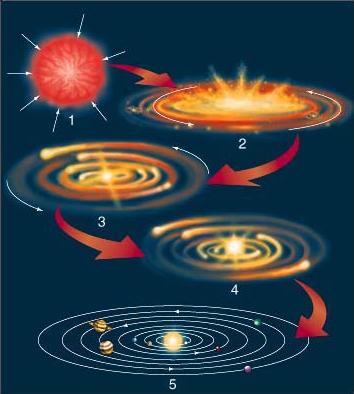Once upon a time, there was a huge interstellar cloud of cold, low-density gas called the solar nebula. This solar nebula came about from billions of years of galactic recycling, and consists of about 98% hydrogen and helium and 2% other random elements. The solar nebula collapsed under its own gravity, and BOOM! the Sun and planets were born!
After the solar nebula went through its initial gravitational collapse, three things happened that shaped it into what our solar system is like today.
First, the solar nebula heated up. Its heating represents energy conservation! As the cloud was collapsing, the cloud became smaller in size due to all the gas particles movements. As gas particles kept on crashing into each other, their kinetic energy was converted into thermal energy. Eventually, our Sun formed in the center, where temperatures and densities were the highest.
The solar nebula also spun faster and faster as it got smaller in radius. The spinning represented conservation of angular momentum. The rotation of the solar nebula allowed everything to be well distributed throughout, which is how we ended up with objects everywhere in our solar system.
Finally, the solar nebula flattened out. It started out as a spherical shape, but with the spinning of the cloud and particles colliding, the gas collide and merge together. Because of conservation of momentum, each collision results in the new clump of gas having the same average velocity as all the molecules together. This kept happening, until the entire cloud flattened. This led to the elliptical planetary orbits being in roughly the same plane, and in the same direction.

Now, our solar system is all grown up!! Our planets happily orbit around the Sun. Everything that the solar nebula went through resulted in the orderly fashion that our planets and other objects orbit and rotate.
Leave a comment